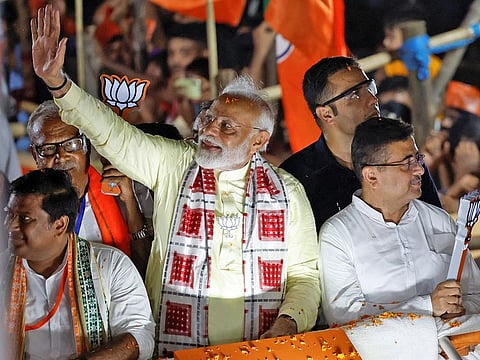World’s largest democracy awaits historic election outcome
Civil society and public intellectuals weigh in on Modi’s governance amid election frenzy

With only one phase, the very last one left, scheduled for June 1, the question on everyone’s mind is who will form the next government in India. Understandably so. Because not only is India the most populous nation on the planet, it is also the largest democracy known to humankind.
With almost a billion people eligible to vote, of which close to an estimated 650 million or more expected to cast their ballots, this election has been keenly watched all over the world. Naturally, the attention of the world, as of India itself, will now shift to the outcome, which will be known on June 4.
As I argued in my last column, few – even the worst and most vociferous critics – have any serious doubts about the ruling Narendra Modi-led Bharatiya Janata Party (BJP) returning to power.
The present administration, on its part, has already prepared for a grand inaugural ceremony, with feelers sent out to world leaders, especially G20 members and friendly neighbours.
As if to allay fears of foreign and Indian investors, Home Minister and BJP’s number two in command, Amit Shah, dropped significant hints that his government will return to power.
Apart from scoring political brownie points, which all those fighting elections habitually do, Shah is sure to have very detailed constituency-wise ground reports on which to base his assertion.
The real question, then, is with what margins of victory. That question is very much up in the air. In fact, when it comes to actual numbers, no one can predict the outcome of not just this, but any election. Psephologists and astrologers included.
Being neither psephologist nor astrologer, but only an analyst and commentator, I would not even dare to speculate on actual seat counts, vote shares, and specific results. Yes, what I can do is observe and interpret trends.
Indeed, with a gag order by the Election Commission even on those who have actual data at their disposal so that they do not influence voters’ behavior, there is more or less a level playing field as far as the predictive power of the so-called electoral experts and pundits goes.
Yes, Modi’s BJP started far ahead. Now, towards the close of the race, it still remains so by a considerable margin. Very likely comfortably ahead to form the government either on its own or with the help of its allies. What, then, has been the real surprise in this otherwise predictable election?
No, it is not the unexpected pushback from the opposition, the Indian National Developmental Inclusive Alliance (I.N.D.I.A). The truth is that though they may have done better than expected, it might just be a case of too little too late.
Heartburn among BJP loyalists
After all, the I.N.D.I.A allies are fighting each other in crucial states such as West Bengal. Despite the twists and turns of Arvind Kejriwal’s arrest and of the Prajwal Revanna sex-tapes scandal tainting BJP’s National Democratic Alliance (NDA) Karnataka partner, Janata Dal (Secular), it is not the efforts of the opposition that are likely to win them many more seats.
It is, instead, the surfacing of some of the contradictions with the BJP, an inevitable result of being in power for ten years. These contradictions include welcoming with open arms turncoats from opposition parties, even giving them as many as 25% of the tickets.
This has caused considerable heartburn among BJP loyalists and local cadres, possibly accounting for the lower turnout among BJP supporters. Another factor is the possible dissatisfaction and disgruntlement in the parent organization, the Rashtriya Swayamsewak Sangh (RSS), which is reportedly miffed with the BJP on several key issues.
One of these is the cutting down of other national and regional leaders – apart from Modi – almost to non-entities. The excessive centralisation of power is, understandably, not to the liking of the RSS. Its traditional stance has always emphasised the nation over any individual and ideology over any personality. No matter how remarkable.
Dependence on Brand Modi
And who can deny that Modi is the tallest Indian political leader not just today, but in the last several decades? Yet, staking all on Brand Modi does not come without its attendant risks.
One of these has been the negative fallout of the ‘Modi one-man show’ narrative criticized not just by the opposition but by key civil society influencers and intellectuals.
This brings me to the crucial part of my argument. It is not so much the opposition’s fightback that has been the x-factor in these elections.
It is the very strong disapproval, even censure, of Modi himself and this BJP government by a whole host of civil society leaders, social media influencers, public intellectuals, and a small section of mainstream media too.
Despite the tremendous firepower of the BJP media cell as well as the unmatched resources and skills of its narrative management apparatus, these anti-Modi voices have not been silenced or erased.
Whether the powerful counter to the official narrative provided by these alternative voices will result in a significant dent in the BJP’s votes is not yet clear. But what is certain is that they demonstrate the strength and diversity of Indian public opinion, making it one of the world’s most diverse and vibrant democracies.
In the most keenly contested constituencies, a remarkable trend is the higher turnout. It is here that the common voter in India knows that his or her vote really matters.
And that, we must all agree, is the essence of democracy.
Sign up for the Daily Briefing
Get the latest news and updates straight to your inbox




